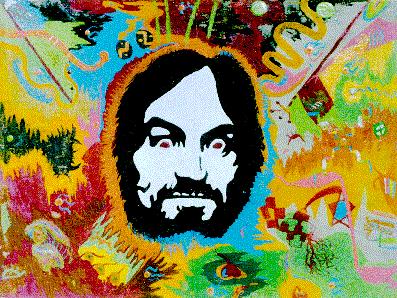Charles Manson, Self Portrait, Image via http://rcjustice.tripod.com/manson2.html
I recently attended a School of Life discussion between philosopher John Armstrong and artist Del Kathryn Barton on the subject of Art as Therapy, coinciding with Armstrong and Alain de Botton’s collaborative book of the same name. The approach was refreshingly convivial, with two fascinating speakers sharing their experiences transcending ennui and anxiety through Art. Neither mentioned the well-established tradition of Art Therapy in the treatment and study of mental health, preferring the School of Life’s established feelgood brand of emotional-intellectual optimism.
Given the subject, question time inevitably brought up Myuran Sukumaran and Ben Quilty, and how the evidence of the former’s art and the latter’s appreciation exonerate the unfortunate prisoner. The crowd murmured and nodded, accepting hand-wrought beauty as proof of humanity and evidence of rehabilitation: Sukumaran deserves peace on account of his redemption, as symbolised by his art.
Armstrong asserts that art is necessary “to bring you serenity, to bring you an image of hope,” but what about the criminals society deems undeserving of such comfort? Spanner-thrower that I am, I wanted to hear about the uncomfortable exceptions.
Enter two names synonymous with modern evil: John Wayne Gacy and Charles Manson. Both are remorseless in-for-life murderers and enthusiastic artists. Claiming ignorance of these personalities, Armstrong steered the topic to familiar territory: many great artists have historically been truly terrible people yet that doesn’t negate their cultural contribution. Barton chimed in that she’d love to see the work of a really truly dark human being.
As the conversation wore on both Armstrong and Barton began to shift uncomfortably as the broader implications of their statements sank in. Of course we’d like to see the products of a grim and tortured mind, Armstrong valiantly went on to clarify: and that’s okay as long as the work doesn’t glorify the crimes.
But what if a criminal paints without insight and for attention, the public only interested in the painting because of the notorious crime associated with it?
Sukumaran’s paintings showcase brilliant talent under duress: a man unreasonably condemned, transcending the brutality of his sentence. Cue doves circling a minaret, wistful tears, triumph of the human spirit and other patronising Shawshank cliches. Yet when I see John Wayne Gacy’s prison self-portraits I shudder; and not just because they are objectively shoddy. I imagine a feverish ghoul masturbating over his gory dreams; ham-fistedly besmirching a canvas with flat and uninspired self-promotion, undeserving of the hope art represents. Without contrition, anything touched by the criminal becomes a celebration of the crime. Just ask Rodney Pople about his 2012 Glover prize win featuring Martin Bryant.
As Camille Paglia wrote in Sexual Personae, “most pernicious … is the notion that there is no person behind a text.” Glimpsing dark minds via their art is the ultimate scary movie: voyeuristic flirtations with the worst in human nature, grim pornography for the soul.
Repentant criminals, having experienced true grotesquery and tempered it with regret, can safely lift the veil so the rest of us may watch the shadows. Australians aren’t entitled to make financial gain on the back of their crimes, but tell that to Chopper Read. He knew the voyeuristic urge is strong, and all it takes is a little narrative construction to turn notoriety into fame. And when consumers start finding a creator’s amorality attractive, things get ethically perilous very quickly indeed.
Severe Aspergers rendered Martin Bryant mentally incapable of remorse or explanation for the massacre he committed (despite being declared legally sane), so he drew six pictures (two abstract, four representational, all tantalisingly described as ‘dramatic’) for the investigators. Ghastly insights supposedly revealed by these drawings were touted by The Age on the 10th anniversary of the massacre, the author’s tone grimly proud: we can’t see the pictures but we’re assured Bryant is ‘a shambolic wreck,’ silent, overweight, receiving letters from sick puppies he doesn’t or can’t read; his life a colourless drudge toward death… Hooray, I guess? Issei Sagawa (who murdered and ate a French student in 1981) made a living in the decade after his imprisonment writing restaurant reviews and tell-all books, only sinking into well-deserved ignominy in the mid-2000s when society collectively shook its head and sobered up. Recently folks flocked to see (and read) American Sniper, eager to peer into the mind of a remorseless killer and ‘good guy’. The success of the TV show The Killer Speaks should probably make us all very uncomfortable, not to mentioned the continued protected status of predatory auteurs like Roman Polanski and Woody Allen.
In formal Art Therapy, traumatised children are often encouraged to draw; the abstract exercise of representation soothing and clarifying a shattering experience. Children are removed from the trauma by the act of drawing, their message interpreted by capable adults. I argue that in this context art acts as sedation. Barton, who also manages anxiety with art, might agree. My own art practice places my observational mind in a still centre, allowing me to express whatever’s going on within. It’s my force-field in a cyclone: the storm rages on, but now I can watch the wind: see the movement but not move with it. I can describe what is happening and be understood. If I remove the force-field I’m whipped away with the hurricane, unable to communicate my message even to myself. I might gain insight in my bubble. Equally, I might not. Like any therapy it only works if I’m willing to confront uncomfortable truths rather than just represent them. The injection and the lollipop aren’t the same thing.





